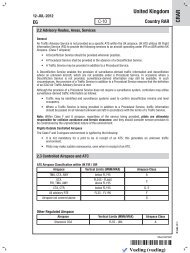No Title for this magazine
Create successful ePaper yourself
Turn your PDF publications into a flip-book with our unique Google optimized e-Paper software.
12-JUL-2012<br />
EG<br />
2.2 Advisory Routes, Areas, Services<br />
C-10<br />
United Kingdom<br />
Country RAR<br />
General<br />
Air Traffic Advisory Service is not provided as a specific ATS within the UK airspace. UK ATS utilizes UK Flight<br />
Information Service (FIS) to provide the following services to an aircraft operating under IFR on ADR within UK<br />
Airspace. (Class F airspace):<br />
• A Deconfliction Service should be provided wherever possible.<br />
• A Procedural Service shall be provided in the absence of a Deconfliction Service.<br />
• A Traffic Service may be provided in addition to a Procedural Service.<br />
A Deconfliction Service enables the provision of surveillance-derived traffic information and deconfliction<br />
advice on unknown aircraft, which are not available under a Procedural Service. In occasions where a<br />
Deconfliction Service is not provided, surveillance-derived information may still be available. In such<br />
circumstances, the provision of a Traffic Service in addition to a Procedural Service ensures that the definition<br />
of an ICAO Air Traffic Advisory Service is met.<br />
Although the provision of a Procedural Service does not require a surveillance system, controllers may utilise<br />
surveillance-derived traffic information as follows:<br />
• Traffic may be identified and surveillance systems used to confirm deconfliction minima and level<br />
occupancy.<br />
• Where a Traffic Service is being provided in addition to a Procedural Service, traffic information<br />
should be passed on all relevant unknown aircraft in accordance with the terms of a Traffic Service.<br />
Note: Within Class F and G airspace, regardless of the service being provided, pilots are ultimately<br />
responsible for collision avoidance and terrain clearance, and they should consider service provision to<br />
be constrained by the unpredictable nature of this environment.<br />
Flights Outside Controlled Airspace<br />
The Class F and G airspace environment is typified by the following:<br />
• It is not mandatory for a pilot to be in receipt of an ATS; this generates an unknown traffic<br />
environment.<br />
• Pilots may make sudden manoeuvres, even when in receipt of an ATS.<br />
2.3 Controlled Airspace and ATC<br />
ATS Airspace Classification within UK FIR / UIR<br />
Airspace Vertical Limits (MNM/MAX) Airspace Class<br />
TMA, CTA, AWY below FL195 A<br />
UTA<br />
FIR, TMA, AWY<br />
FL245 - FL660<br />
above FL195<br />
CTA, CTR below FL195 D, E<br />
All advisory RTE FL35 - FL190 F<br />
Airspace not covered above G<br />
Other Regulated Airspace<br />
Airspace Vertical Limits (MNM/MAX) Airspace Class<br />
Shanwick OCA FL55 - UNL A<br />
C<br />
Sheet 601681<br />
*601681*<br />
Vueling (vueling)<br />
CRAR<br />
© Lido 2012
CRAR<br />
© Lido 2012<br />
United Kingdom<br />
Country RAR C-20<br />
12-JUL-2012<br />
EG<br />
Sheet 601681<br />
Airspace Vertical Limits (MNM/MAX) Airspace Class<br />
Parts of the Shanwick OCA delegated to other ATC Agencies:<br />
SOTA (Shannon Oceanic Transition Area) to Shannon ACC<br />
BOTA (Brest Oceanic Transition area) to Brest ACC<br />
RATSU (N61 W010) to Reykjavik ACC<br />
Width of Airways<br />
8-14NM<br />
2.4 Alerting, Search and Rescue<br />
Responsibility for SAR in the UK and the surrounding waters rests with a joint Civil/Military organization. RCC<br />
is located at Kinloss, Scotland.<br />
2.6 General Flight Rules<br />
ACAS/TCAS II<br />
The TCAS II Minimum Equipment List permits TCAS II equipped aircraft to operate for up to 10 days with the<br />
equipment out of service. Any aircraft with an unserviceable transponder as well as an unserviceable TCAS<br />
will not be permitted in UK airspace for which mandatory carriage of a transponder is required.<br />
Noise Abatement Procedures<br />
Noise Abatement Procedures in general do not allow turns to be commenced below a height of 500ft above<br />
aerodrome level. Unless otherwise stated, the upper limit for noise abatement procedures is 3000ft above<br />
aerodrome level. However, aircraft operators are expected to operate their aircraft at all times in a manner<br />
calculated to cause the least noise disturbance on the ground. These criteria are for guidance only and<br />
aircraft operators should adhere to the maximum extent practicable commensurate with the safe operation of<br />
the aircraft.<br />
SSR<br />
Set Mode A Code 2000:<br />
• When entering United Kingdom airspace from an adjacent region where the operation of transponders<br />
has not been required.<br />
• By Mode S transponder equipped aircraft on the aerodrome surface when under tow, or parked and<br />
prior to selecting OFF or STANDBY - unless otherwise instructed by ATC.<br />
Note: Select Mode C pressure-altitude reporting mode simultaneously with Mode A unless otherwise<br />
instructed by an ATS unit.<br />
2.8 Instrument Flight Rules IFR<br />
Approach Ban - All Aircraft<br />
a) An aircraft may commence an instrument approach regardless of the reported RVR/VIS but the<br />
approach shall not be continued below 1000ft above the aerodrome if the relevant RVR/VIS for that<br />
RWY is at the time less than the specified minimum for landing.<br />
A<br />
Vueling (vueling)



